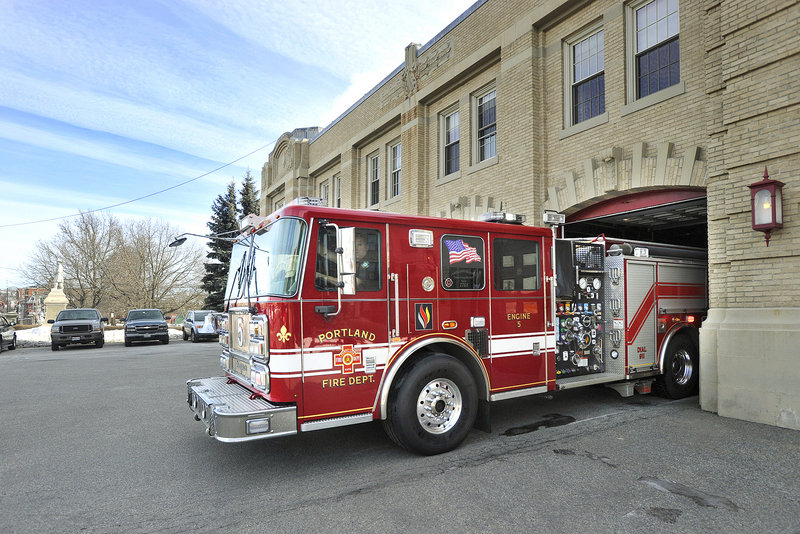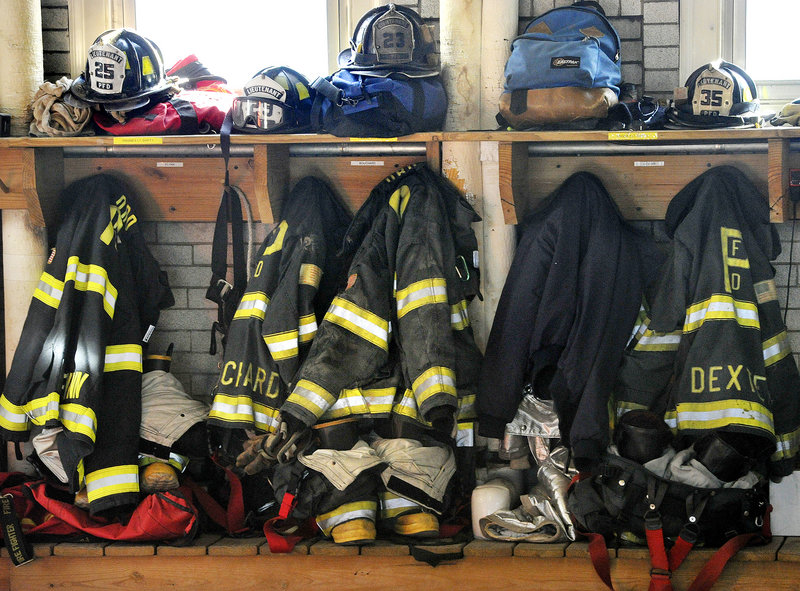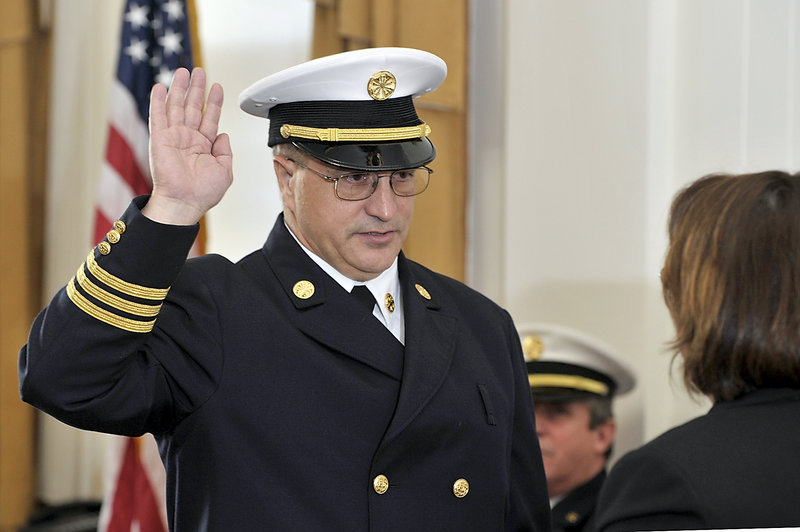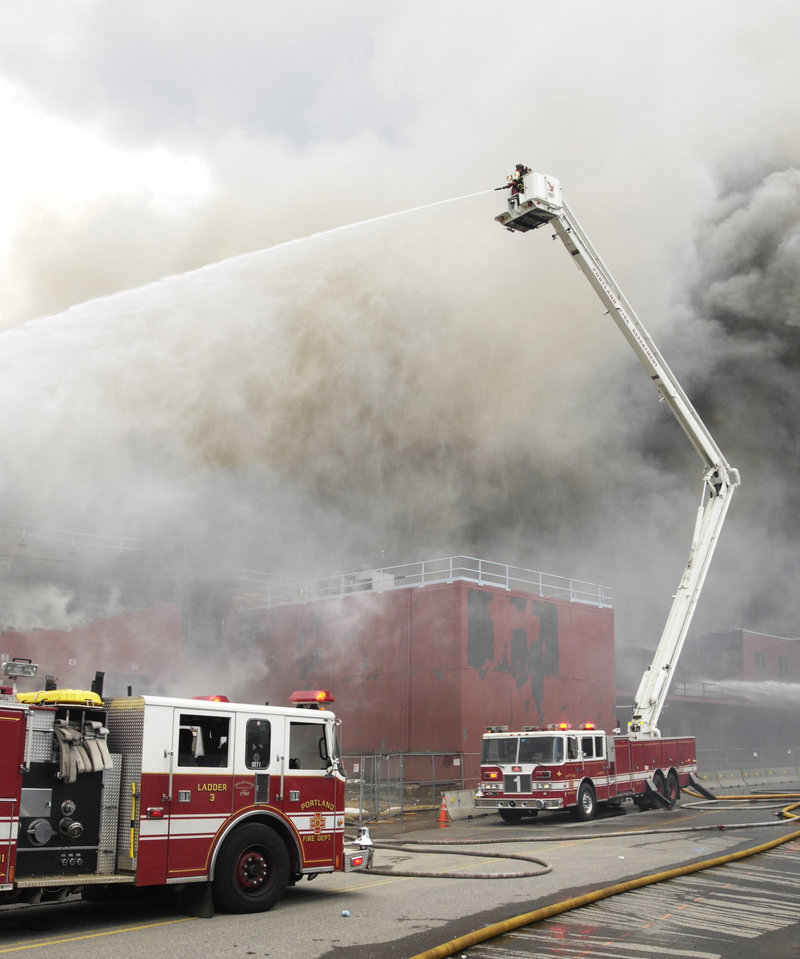Portland employs more full-time firefighters than any other midsized city in New England, according to an analysis by the Portland Press Herald/Maine Sunday Telegram.
The city has 3.54 firefighters for every 1,000 residents, a rate higher than all 45 comparable cities in the region.
On a per-capita basis, no other department even comes close.
The next largest comparable department is in Warwick, Rhode Island, with 2.66 firefighters per 1,000 residents. About half of the communities in Portland’s size range — 40,000 to 100,000 residents — have fewer than 2 firefighters per 1,000 residents.
Despite its large fire staff, Portland struggles to contain overtime costs that have approached or surpassed $2 million in each of the past two years. Among other factors potentially adding to the cost of the city’s $16 million fire department is its 24-hour work shifts, a common practice in the industry that some chiefs say costs more money than it saves.
Staffing in Maine’s largest fire department, which accounts for 8 percent of the city’s $200 million budget, has been a touchy political issue in Portland for years. And it is now the central focus of a top-down review of the department by a team of city consultants, a study that also coincides with the arrival of a new chief.
The newspaper’s analysis of regional staffing levels indicates Portland is an outlier in New England, even among a sample of smaller communities, which tend to have more firefighters per capita. And that finding is supported by two national rankings — an annual profile of U.S. fire departments and an independent ranking based on U.S. Census data released every five years — that show Portland also is a large fire department compared to similarly sized communities nationwide.
“You look at the data and it leaps off the page to me,” said City Councilor Edward Suslovic, who chairs the Public Safety, Health and Human Services Committee and has a key fire department oversight role. “No matter how you analyze the data, Portland, Maine, stands out for having a very large fire department.”
John Brooks, president of the Local 740 International Association of Firefighters union, said in a written statement that comparing fire departments is complicated and that Portland does not have more firefighters than it needs.
“The Portland Fire Department is not over-staffed,” Brooks wrote. “The national standard calls for having four firefighters on a truck and we don’t meet that standard.”
The type and quantity of fire equipment, including ladder trucks and fire engines, can affect staffing levels and also are being reviewed by the consultants.
Mayor Michael Brennan declined to weigh in on the newspaper’s analysis, saying in a written statement that it would be premature to comment on the size of the fire department before the outside consulting firm finishes its report.
“I believe that report and the appointment of the new fire chief will allow the council to map a positive direction for the future,” Brennan wrote.
HOW PORTLAND MEASURES UP
Portland has 234 firefighters, which is actually down from the 300 firefighters employed in 1975. Portland’s population is 66,194.
To compare the size of the department, the Press Herald surveyed 44 fire departments in New England cities with 40,000 to 100,000 residents. It also surveyed some larger communities — Boston, Hartford, Conn., and Providence — and some smaller ones — South Portland, Bangor and Portsmouth, N.H.
Only New England communities were surveyed because they share similar construction patterns, including age and type of housing stock, and other geographic characteristics such as interstates, cargo ports, airports and waterways.
Based on that survey, the average number of firefighters per 1,000 residents for all 54 communities surveyed is 2.16.
Portland’s 3.54 firefighters per capita was the highest on the list, including the smaller and larger cities. Hartford, Conn., was second with 3.15 firefighters per 1,000 residents, Portsmouth, N.H., was third with 2.94, followed by Bangor at 2.72.
Barnstable, Mass., had the lowest per capita at 0.35 per 1,000 residents.
The National Fire Protection Association does not recommend standard staffing levels, but its annual report says the number of firefighters per 1,000 people is “a good way to develop a sense of the size of the department relative to population they protect.”
In 2011, the national median number of firefighters per 1,000 residents in cities with 50,000 to 99,999 people was 1.35, according to the fire protection association. The low was zero and high was 3.46, it said. Portland’s is 3.54.
When asked how Portland could be larger than the national high, one of the report’s authors, Michael J. Karter Jr., said Portland is among a half-dozen communities whose figures were not included in the analysis, because they were outliers that would have inflated the mean number of firefighters per 1,000, misrepresenting the norm.
A separate nationwide comparison of fire departments by City-data.com has Portland tied for 28th for professional firefighters per capita among 2,334 communities with more than 5,000 residents. That ranking is based on information from 2007 from the U.S. Census of Governments — the most recent available, according to website chief executive officer Lech Mazur.
‘DANGER’ IN MAKING COMPARISONS
Portland Fire Chief Jerome LaMoria, who took over the department on Jan. 3, said there is a “danger” in comparing per capita staffing of communities. It’s important to look at emergency-response resources available regionally, he said.
For instance, some fire departments surveyed by the newspaper, especially in Massachusetts and Connecticut, are next to one another and may be satisfied with smaller departments because they rely on each other for support, he said. “That’s a better opportunity for resource sharing,” LaMoria said.
Portland has old, wood-framed homes and buildings that are closely packed, which LaMoria said increases the potential for a large-scale, destructive fire.
But so do other communities, especially those in Massachusetts.
The fire chief in Somerville, Mass., also said square mileage and population density are important when assessing a fire department.
Somerville’s 75,754 people, for example, are crammed into 4.12 square miles. That gives Somerville a density of 18,400 people per square mile. Portland, with 21.31 square miles, has a population density of 3,105 people per square mile.
“Somerville is not a good comparison to Portland,” said Somerville Fire Chief Kevin Kelleher, whose department has 2.01 firefighters per 1,000 residents.
However, there are some good comparisons using those standards.
Brockton, Mass., is 21 square miles and has 4,398 people per square mile; Meriden, Conn., is nearly 24 square miles, with a density of 2,558, and Norwalk, Conn., is 22.86 square miles, with a density of 3,744.
And, while Portland’s fire staffing is 3.54 per 1,000 residents, Brockton, Meriden and Norwalk employ 1.83, 1.63 and 1.52 firefighters per 1,000 people, respectively.
Call volume also can drive staffing levels, but Portland’s 15,000 calls per year does not suggest the city’s department is exceptionally busy.
Meriden, Conn., for example, has a population of nearly 61,000 — about 5,000 fewer residents than Portland — and responded to 13,899 calls in 2012. Chicopee, Mass., which has 55,298 people, responded to 11,000. Brockton, Mass., which has 93,810 people and fewer firefighters than Portland, responded to 21,000 calls last year.
Call volumes were not readily available from most of the 55 communities surveyed by the paper, however. Nor was it clear whether any of the departments offer advanced EMS service like Portland.
A DEPARTMENT UNDER REVIEW
Maryland-based Public Safety Solutions, Inc. began a top-down review of the fire department Jan. 14 and is expected to issue its recommendations in March. The study will cost $39,000.
Brooks, the union president, said firefighters support the review.
“We fully support our new fire chief and the city’s effort to complete a review of department operations. But comparing our department to departments in other cities is complicated,” Brooks said.
Les Adams, the company’s president, said a team of five consultants will spend three to four weeks in the city before producing a 200-to-300-page report that will address staffing, budget, overtime, station locations, and the like.
Adams, who has 22 years of experience working as a firefighter, paramedic and chief officer, said in an interview that he has been impressed with the Portland Fire Department. For an old department, it is progressive in its EMS training for firefighters and staff appears to be open to improvements, he said.
“We’ve done a lot of these studies throughout the years and it doesn’t take us long to get a sense for the outlook and the attitude and potential receptivity of people,” Adams said. “Our initial impression is (firefighters) are receptive and interested in looking for better ways to be doing things.”
Adams, as well as other fire professionals, emphasized that the biggest factor in a fire department’s staffing is what the community is willing to pay for and the level of risk that community is willing to incur.
Shan English, chief executive officer of the Texas-based English & Associates, said station locations, equipment and policies for manning fire trucks also factor into staffing.
Older cities may have fire stations that “are not tactically located,” English said. Some communities can actually save money by consolidating stations and reducing staffing, even if it means spending money to build new stations.
“That’s a fixed cost compared to staffing, which is an annual cost,” English said.
Portland has three fire stations located within 1.6 miles of each other on Congress Street, although it’s unclear if the consultants will recommend any consolidation.
THE OVERTIME FACTOR
Despite having the largest department of mid-sized cities in New England, the department still has trouble containing its overtime costs.
So far this fiscal year, which ends June 30, the department has spent $1.1 million in overtime, according to Nicole Clegg, the city’s spokeswoman. The city spent $1.8 million in overtime in fiscal 2011-12 and $2 million in 2010-11. The department averaged $1.3 million in overtime costs in the seven years leading up to fiscal 2011, Clegg said.
While data on overtime spending in other departments was not readily available or easy to compare, Portland’s rising overtime costs were one of the major reasons the city hired an outside consultant to review the department.
“The fire department is an area of concern,” City Councilor John Anton, who leads the Finance Committee, told the Press Herald back in September when discussing the review. “It’s one of the biggest budget drivers.”
It’s unclear what drove up Portland’s overtime costs in recent years, but it’s an area LaMoria is looking to get a handle on.
“I’m very, very concerned about overtime,” LaMoria said. “It’s something that needs to be looked at closely. Nothing is off the table when it comes to bringing the department within budget.”
ASSESSING UNION’S MIGHT
Changing a fire department’s culture can be a difficult task.
LaMoria, however, said he has been impressed with Portland firefighters’ apparent openness to change.
“What you see as tradition, I see as organizational pride; that is the cornerstone of a great organization,” LaMoria said. “I don’t believe the men and women of the Portland Fire Department are as steeped in tradition and stubborn about change as they have been painted as.”
Brooks, the union president, said in a written statement that Portland firefighters are welcoming the outside review of the department. However, in a recent newsletter posted online, the union warned firefighters about a long year ahead.
The newsletter mentions “a certain councilor or two” who don’t want to extend a $1.05 million federal grant that funds about a dozen firefighters, because accepting the money could prevent the city from making staffing changes at the department.
“It’s obvious we have a few long months ahead of us,” the newsletter says. “Our system is working and it’s due to our staffing size. Reducing staffing will result in a less safe city to work and live in.”
In the past, Portland’s union has been active politically and rallied support from out of state when it comes to staffing issues.
In 2008, firefighters rejected a pay freeze that was accepted by six of the eight city unions.
When the city laid off nine firefighters, union members held a demonstration on the steps of City Hall that drew more than 200 people. About 25 firefighters, including some from Rhode Island, protested on motorcycles, revving their engines before the protest started.
At the rally, members of Local 740 handed out fliers with city councilors’ contact information. They argued public safety was at risk because of the reductions.
The layoffs went through, but a federal grant allowed the city to refill those positions. That grant expires at the end of June. It’s unclear whether the federal government will offer a two-year renewal, and if the city would even accept it.
A more colorful example occurred about a decade ago when firefighters campaigned in support of Orlando Delogu, who opposed shuttering two fire stations and laying off two dozen firefighters.
“Orlando Delogu would never let your safety be compromised,” says a pamphlet made and distributed by the union. “Portland’s firefighters and paramedics would not steer you wrong!”
In addition to distributing campaign literature, Delogu said firefighters picked him up at his home in an antique fire engine and drove him around town, touting his candidacy through a bullhorn while ringing the fire bell.
Delogu lost the election, but the fire stations never closed.
This story was updated at 12:05 p.m. on February 6, 2013 to correct the number of firefighters in Taunton, Mass., and the associated chart. Taunton has 120 firefighters, or 2.15 per 1,000 residents.
Staff Writer Randy Billings can be contacted at 791-6346 or at:
rbillings@mainetoday.com
Twitter: @randybillings
Send questions/comments to the editors.






